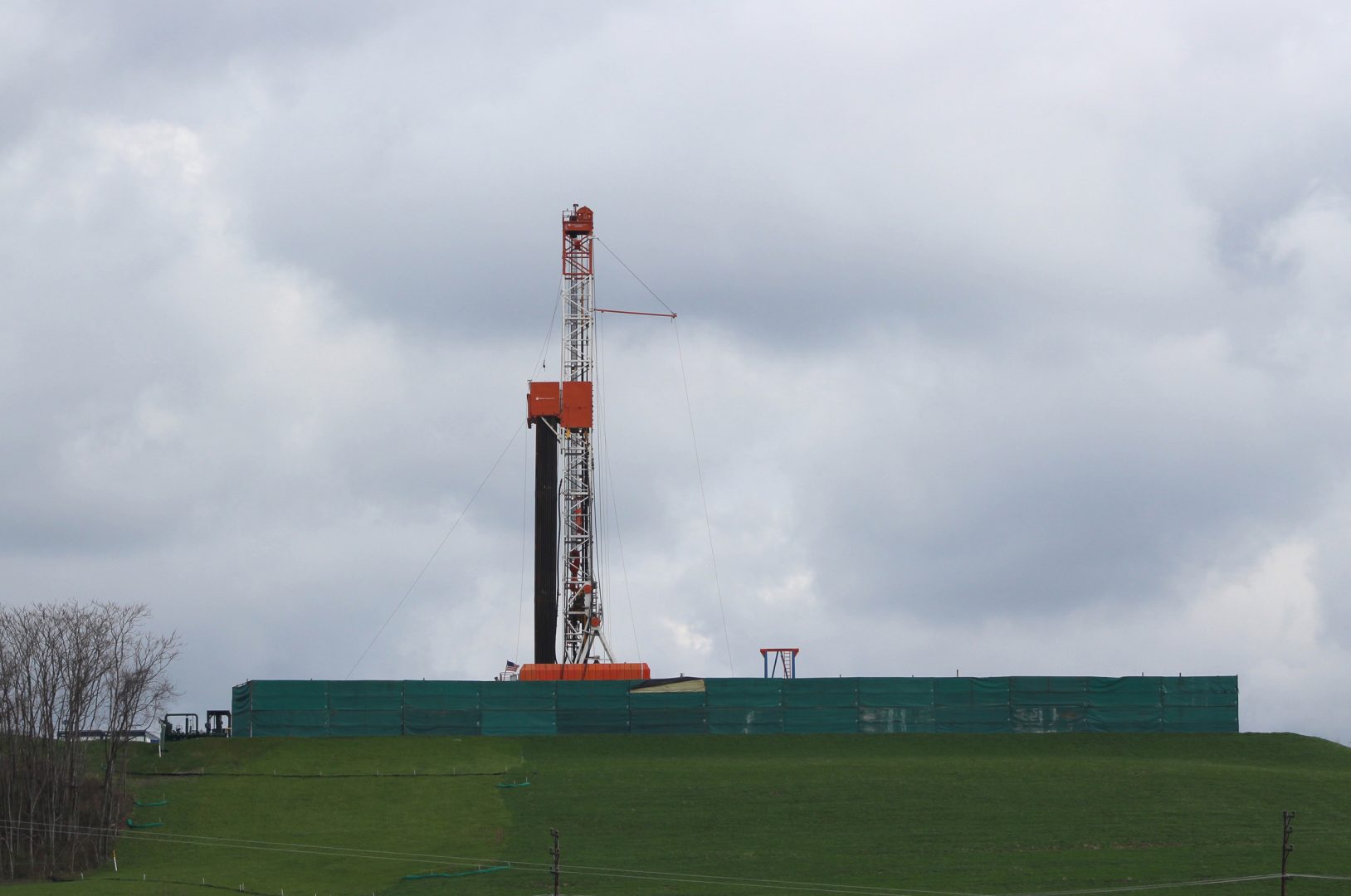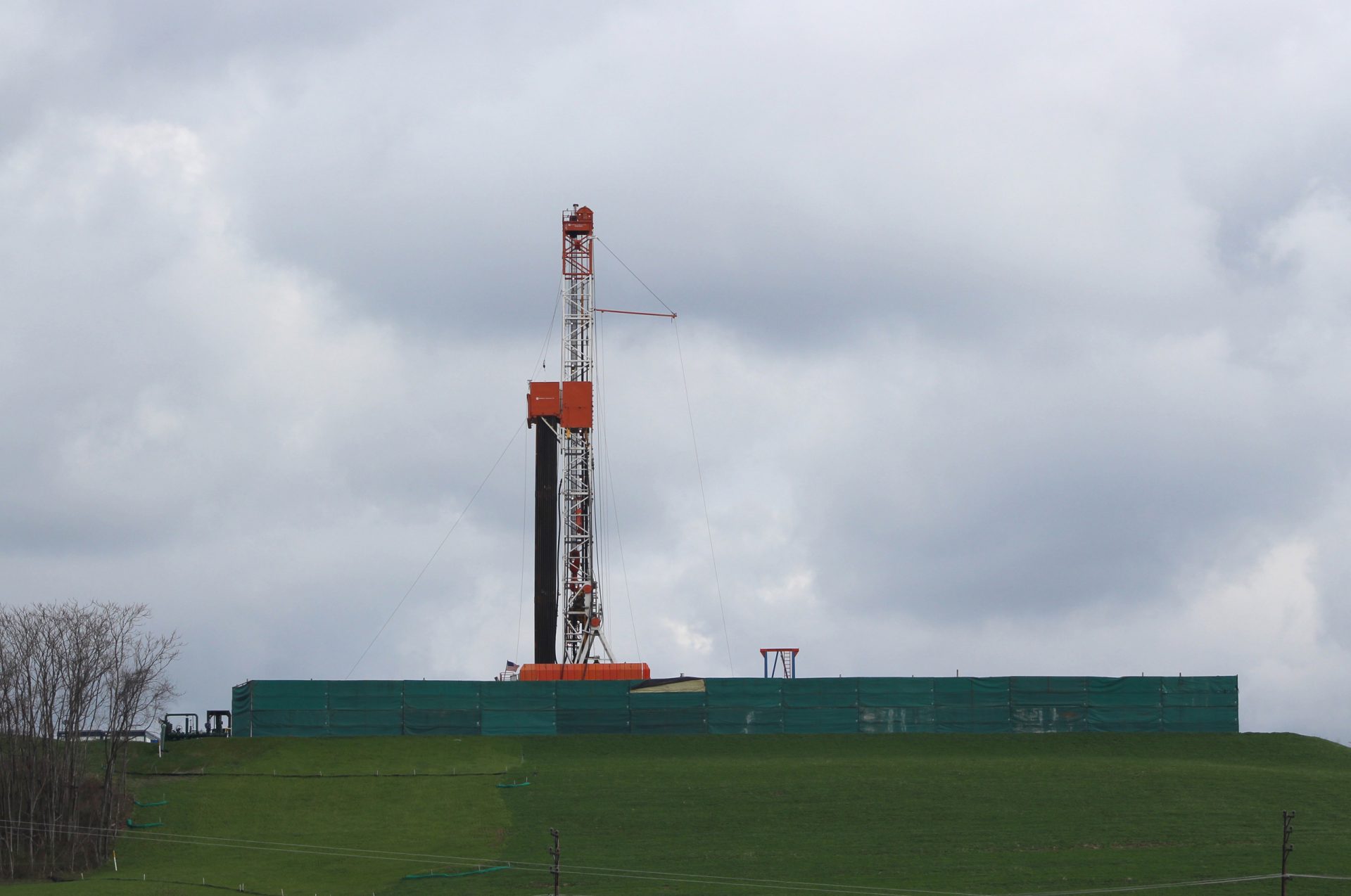
A shale gas drilling rig in Washington, Pa.
Michael Rubinkam / AP Photo


A shale gas drilling rig in Washington, Pa.
Michael Rubinkam / AP Photo

Michael Rubinkam / AP Photo
A shale gas drilling rig in Washington, Pa.

Michael Rubinkam / AP Photo
A shale gas drilling rig in Washington, Pa.
A new study by Carnegie Mellon University finds that in Pennsylvania, Ohio, West Virginia region, the economic boost from shale gas drilling has been less than the cost of premature deaths caused by pollution from the industry.
The study, published last month in the journal Nature Sustainability, found that between 2004 and 2016 shale development created a regional economic boost of $21 billion dollars, compared with $23 billion in the costs related to the 1,200 to 4,600 premature deaths linked to air pollution from the industry.
Lead author Erin Mayfield, a postdoctoral fellow at Princeton University, who studied the shale gas boom while a doctoral student at Carnegie Mellon, wanted to build on the growing body of economic, environmental and health research to create a cost-benefit analysis of the gas industry over time.
“These are largely unexplored areas, and really unaccounted for in public and private decision making,” Mayfield said. She wanted to look at cumulative impacts, both positive and negative, of the industry. “So, who are winners and who are losers?”
The answer was pretty clear, according to study co-author Nick Muller, associate professor of economics, engineering, and public policy at Carnegie Mellon. [Another co-author, Jared Cohon, is on the board of directors for The Heinz Endowments, which is a funder of The Allegheny Front.]
“We show that the biggest employment effects are in outlying rural areas. And not surprisingly, those communities have benefited in some ways from this,” Muller said. “The natural gas extraction activity, however, where we find the greatest concentration of premature mortality from the local air pollution is in both the Pittsburgh metropolitan area and also the bigger cities to the east where that air pollution eventually flows.”
The study found that 54 percent of shale related jobs were in rural areas (and an additional 31 percent in rural-urban mixed areas), while 76 percent of premature deaths associated with the gas industry occurred in urban areas.
The authors used various data sets and modeling to calculate the estimated economic, health and climate impacts.
The study looked at “job-years,” defined as a full- or part-time job over a single year, not a long term job or career, created by or related to the industry. It finds the shale industry supported an estimated 469,000 job-years(±30%) over the twelve year study period.
The peak year, 2014, meant 74,000 estimated shale related jobs in the tri-state region, but also the highest estimated premature mortality.
The study estimated premature deaths related to air pollution associated with gas wells, compressor stations, and other infrastructure, including fine particulate matter (PM2.5), nitrogen oxides (NOx), and volatile organic compound (VOC) emissions.
The authors used data from various studies to estimate air pollution from upstream processes like drilling and hydraulic fracturing. For all other air pollution sources from natural gas, such as processing, transmission and power generation, the authors used facility level data reported by the U.S. Environmental Protection Agency’s National Emissions Inventory (NEI).
In 2014, they estimated emissions from shale gas activity accounted for 10% of NOx emissions reported by all industries to NEI in the tri-state region. Emissions of PM2.5 and VOCs were considered marginal, at less than 2%.
Using air modeling, the researchers then tracked where the air pollution would go geographically, and looked at the populations that would be impacted, “And then we use epidemiological studies to link the exposure level to adverse or increases in mortality,” Muller said. “And then we monetize those with standard techniques that EPA uses that convert mortality risks to dollar damage.”
Dr. John Holdren, professor of environmental policy at the Harvard Kennedy School of Government and co-director of the Program on Science, Technology, and Public Policy, reviewed the study at the request of the Allegheny Front this week and said it looked “solid” but added that “there are some big uncertainties in the data.” For example, he said, estimates of employment effects and premature deaths related to gas development have large margins of error.
Holdren has been doing analysis like this, looking at the social impacts of fossil fuel energy generation, since the late 1960s, including during his tenure as President Obama’s science advisor and director of the White House Office of Science and Technology Policy. “In many respects, this is a more detailed review than we were able to do in the Obama administration,” he said.
Dr. Jillian Goldfarb, assistant professor of biological and environmental engineering at Cornell University, said the data in the study is “definitely sound,” and the methodology and data sources they draw from are “well respected, and used across the field.”
The study authors see this cost-benefit analysis of gas development as providing a template for other communities to use. In response, Goldfarb, who is active with the American Chemical Society, a nonprofit organization, called the CMU study “…a good jumping off point, but it’s not the whole story.”
The study does not account for lower carbon footprint of natural gas, compared with coal, which the authors mention in their paper. “Replacing electricity generation from coal to natural gas short term is beneficial, but they don’t model this,” she said, while noting that comparing coal and natural gas “…would be a study itself.”
Goldfarb also questions whether health impacts can really be assessed. “It’s an industry that was really getting going in 2004,” she said, so attributing deaths to gas emissions starting just a few years later, as the study does, “…is difficult to verify.”
Goldfarb would also like to see water impacts included in a cost-benefit analysis of the gas industry.
In statement, the Marcellus Shale Coalition president David Spigelmyer said all energy sources create impacts and tradeoffs, and “…natural gas is unquestionably enhancing our environment and air quality, boosting job creation and making American more secure.”
He also pointed to the benefits to consumers from “the availability of low-cost, affordable and clean-burning American natural gas.”
The study estimated that climate impacts from natural gas development in the region cost $34 billion during the study period, which is more than either the employment benefits or the air pollution impacts. Muller said the climate impacts are “a significant contributor to the overall social cost from gas extraction in the region.”
The study found that natural gas related sources in Pennsylvania, Ohio and West Virginia accounted for 10 percent of all US methane emissions, and 9 percent of the carbon dioxide emissions across the entire US natural gas sector.
Natural gas is often touted as better for the climate than coal. Muller said this movement from coal to natural gas for power generation likely generates some benefits, but “there [are] still significant climate change damages associated with its use.”
“This study highlights the need for more discussion about why we’re signing up to do more with this industry,” said Mehalik, referring to the petrochemical plant being built by Shell in Beaver County, north of Pittsburgh. It will use the ethane in natural gas to make raw material for the plastics industry.
Carnegie Mellon’s Nick Muller hopes the study provides information policymakers need to evaluate the costs and benefits of the natural gas industry. “Our job in this paper was to present the tradeoff, not to conclude what to do about the tradeoff,” he said.
StateImpact Pennsylvania is a collaboration among WITF, WHYY, and the Allegheny Front. Reporters Reid Frazier, Rachel McDevitt and Susan Phillips cover the commonwealth’s energy economy. Read their reports on this site, and hear them on public radio stations across Pennsylvania.
(listed by story count)
StateImpact Pennsylvania is a collaboration among WITF, WHYY, and the Allegheny Front. Reporters Reid Frazier, Rachel McDevitt and Susan Phillips cover the commonwealth’s energy economy. Read their reports on this site, and hear them on public radio stations across Pennsylvania.
Climate Solutions, a collaboration of news organizations, educational institutions and a theater company, uses engagement, education and storytelling to help central Pennsylvanians toward climate change literacy, resilience and adaptation. Our work will amplify how people are finding solutions to the challenges presented by a warming world.